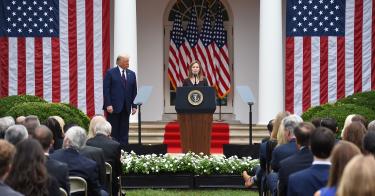I was a kid, my dad held up three fingers and asked, “Does this two look like a three?” Little did I know that this attempted sleight of hand would become a regular feature of the process for appointing federal judges. Watch for it in the days ahead as the Senate considers President Donald Trump’s expected nomination of U.S. Circuit Judge Amy Coney Barrett to the Supreme Court.
We can be certain this will happen because it already has. Barrett co-authored a 1998 article with Notre Dame law professor John Garvey that was published in the Marquette Law Review. They examined the possible conflict for a Catholic judge between her religious faith and her judicial responsibility in death penalty cases. They wrote: “Judges cannot—nor should they try to—align our legal system with the Church’s moral teaching whenever the two diverge.” The solution to an irreconcilable conflict is “the recusal of judges whose convictions keep them from doing their job.”
Nearly two decades later, Barrett appeared before the Senate Judiciary Committee after Trump nominated her to the Seventh Circuit. Pressed by Democrats about that article, Barrett said that if she faced a conflict between her religious faith and judicial duty, “I would recuse. I would never impose my own personal convictions upon the law.” It is “never appropriate,” she added, “for a judge to impose that judge’s personal convictions, whether they derive from faith or anywhere else, on the law.”
Such clarity is hard to find, and even harder to beat. In writing and in spoken word, Barrett rejects allowing her personal views to drive her judicial decisions. As if anticipating that some would still not get it, she even used the word “never.”
>>>Amy Coney Barrett, in Her Own Words
No matter. The Alliance for Justice’s number-one reason for opposing Barrett’s Seventh Circuit nomination was that she “thinks judges should put their religion ahead of the law.” Wait, what?
“Barrett believes,” AFJ insists, “that judges should be able to put their religious views above their judicial oath to the follow the law, the Constitution and precedents of the Supreme Court and the Courts of Appeal. It’s a pretty unheard of idea in the American judiciary.” Yes, that idea is pretty unheard of, and no one has rejected that idea more clearly or completely than Judge Barrett.
Does this commitment to set aside personal views look like a determination to impose them? Does this two look like a three?
Not only does Barrett explicitly reject the suggestion that judges may even attempt to base their decisions on their personal views, but she endorses an approach to judging that guards against it. Last year, in Gamble v. United States, Justice Clarence Thomas wrote a concurring opinion defining the “modest” judicial task: “We interpret and apply written law to the facts of particular cases.” Barrett is committed to an approach to interpretation that minimizes the influence of her personal views. The heart of that approach is textualism and originalism.
Justice Antonin Scalia, for whom Barrett clerked, has observed that the law federal judges use to decide their cases is written law—the Constitution, statutes, regulations. In his book Reading Law, Scalia explains that the textualist “look[s] for meaning in the governing text, ascribe[s] to that text the meaning it has borne from its inception, and reject[s] judicial speculation about both the drafters’ extratextually derived purposes and the desirability of the fair reading’s anticipated consequences.”
Barrett has similarly written that the “bedrock principle of textualism, and the basis on which it has distinguished itself from other interpretative approaches, is its insistence that federal courts cannot contradict the plain language of a statute, whether in the service of legislative intention or in the exercise of a judicial power to render the law more just.”
Textualism limits a judge’s interpretive discretion, or the choices a judge has when trying to determine what the law means. Speculating about the purposes of a law, the anticipated consequences of interpreting it different ways, or trying to render it more just are noble-sounding ways of saying that judges are trying to remake the law in their own image. That opens the door for their personal views, preferences, prejudices, and priorities to become the engine of their decisions.
Textualists like Barrett deliberately try to keep that door closed. Judges, of course, are humans, not robots. They cannot eliminate the influence of personal views or beliefs completely. But the alternative to sanitized, perfectly objective interpretation is not a free-for-all where judges just it up as they go along. For cases to be decided as much as possible by the law rather than by the judge, there must be a real understanding of the need for such impartiality, a self-conscious conviction to achieve it as much as possible, and the actual use of tools that help make it real.
Judge Barrett is that kind of judge. In the coming days, the media, the public, and even the Senate should read and listen to what she has actually written and said and consider her record for what it is. Don’t buy the lie that what looks like a three is really a two.
This piece originally appeared in the National Review




